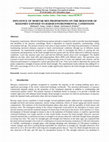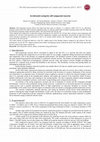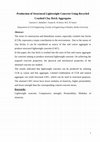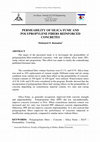Papers by Osama El Hariri

The reuse of construction and demolition wastes, especially crushed clay bricks (CCB), represents... more The reuse of construction and demolition wastes, especially crushed clay bricks (CCB), represents a major contribution to the environment. Due to the nature of clay bricks, it can be considered as source of fine and coarse aggregate to produce structural lightweight concrete (LWC). In this paper, the clay brick is crushed into the sizes of fine and coarse aggregate for concrete aiming to produce structural lightweight concrete. On achieving the targeted concrete properties, the physical and mechanical properties of the obtained concrete are studied. The results indicated that lightweight concrete can be produced by utilizing CCB as coarse and fine aggregate. Limited combination of CCB and natural aggregate can yield structural LWC, which can be used in structural purposes. The attained LWC mixes have lower modulus of elasticity, higher permeability and lower strength than the corresponding control concrete mixes.

أجریت دراسة لتحدید الأسباب المحتملة للانھیار الذي وقع في نظام البلاطات الخرسانیة مسبقة الإجھاد ما... more أجریت دراسة لتحدید الأسباب المحتملة للانھیار الذي وقع في نظام البلاطات الخرسانیة مسبقة الإجھاد ما بعد الصب أثناء صب بلاطة الدور السابع لبنایة خرسانیة متعددة الأدوار تقع في الخبر بالمنطقة الشرقیة من المملكة العربیة السعودیة، حیث انھارت البلاطات (system في كل من في الدور السابع (أثناء صبھ) والدور السادس (الحامل لشدة الصب). ھذه الورقة تعرض ھذه الدراسة، بما فیھا وصف المبنى وحادث الإنھیار. تنحصر احتمالات بدء الانھیار في بلاطة الدور السادس أولا، أو انھیار الشدة والبلاطة التي تحملھا أولا. وفي كلا الحالتین، كان ھناك ضعف في قوة تحمل بلاطات الدور السادس أدى إلى انھیارھا بینما بلاطات الدور الخامس والمنفذة من الخرسانة المسلحة والتي وقعت علیھا أحمال أكبر لم یحصل فیھا انھیار. الأسباب المحتملة لانھیار بلاطة الدور السادس تشمل أخطاء تنفیذ حدید التسلیح العادي في البلاطة، حیث رصدت أخطاء جسیمة في تسلیح بلاطة الدور السابع تحت الصب، وكذلك تأثیر مواقع نقاط الشد ومجاري الخدمات على قوة تحمل منطقة تحمیل البلاطة على العمود، وأخیرا انخفاض قوة عینات الخرسانة المأخوذة من المبنى عن القیم التصمیمیة. أما الشدة الحا...

International Journal of Civil Engineering and Technology
Unreinforced masonry is the construction system of most of historic structures and a considerable... more Unreinforced masonry is the construction system of most of historic structures and a considerable percentage of existing residential buildings in Egypt. One of the important disadvantages of unreinforced masonry construction is its low resistance to tensile stresses and lateral loads, so there is frequently need for appropriate strengthening for such structures. Fiber reinforced polymer (FRP) composites have been successfully applied as externally bonded reinforcement for strengthening of reinforced concrete and masonry structural elements as well. Their excellent strength-to-weight ratio and easy installation make them an attractive alternative for traditional strengthening methods. This paper presents experimental investigation of strengthening masonry walls and vaults using FRP composites, as well as other traditional methods such as steel reinforcement bars, ferro-cement layers and polymer mortar layers. The experimental program is explained and the maximum capacity and failure ...

Wall bearing structures was formally introduced to the Egyptian field of construction industry in... more Wall bearing structures was formally introduced to the Egyptian field of construction industry in 1995. Due to the limited use of masonry in the last four decades, typical engineers did not gain the sense and experience of this kind of structures. In this research, 15 different mortars made with sets of combinations of OPC, lime, Condensed silica fume (CSF), and polypropylene fiber (PPF), were used with silt and cement bricks. The compressive strength of masonry prisms, made of one brick long, three bricks high, were studied for each mortar at the age of 28 day, 3 months and one year. The study showed that the behavior of cement brick is superior to the silt brick. Compressive strength of masonry prisms were affected by mortar strength, addition of CSF, the presence of lime and PPF. The strength of cement brick masonry prisms increased with time till the end of testing period while silt brick prism strength deteriorated after 3 months. The used prism is recommended to be used as a m...

Reactive Powder Concrete (RPC) is a new family of high strength cement based composites that achi... more Reactive Powder Concrete (RPC) is a new family of high strength cement based composites that achieves high levels of compressive strength. The introduction of the RPC opened new applications for engineers and researches. This paper presents an experimental program of two phases. The first phase included 36 mixes to investigate the possibility of producing RPC using materials available in the local Egyptian market. Also, optimizing the content of the constituent materials of RPC was studied. Key variables were water/cement ratio, quartz, silica fume and steel balls. The second phase included six mixes, M1 to M6, to evaluate the structural properties of reactive powder concrete. In addition, the effect of curing regime and some durability aspects, such as drying shrinkage and sulphate attack, were investigated. The results demonstrated that reactive powder concrete can be produced using materials available in the local Egyptian market. A compressive strength up to 160 N/mm 2 and a fle...

This paper investigates the effects of different levels of expansion resulting from alkali-carbon... more This paper investigates the effects of different levels of expansion resulting from alkali-carbonate reaction (ACR) on mechanical properties of concrete at different ages. Concrete prisms and companion cylinders were cast with three aggregates that are non-reactive, marginally-reactive and highly-reactive, and cured under the same conditions. The concrete prisms showed 1-year expansion values of 0.021 %, 0.042 % and 0.271 % for the non-reactive, marginally-reactive and highly-reactive aggregates, respectively. In general, the results showed a reduction in mechanical strengths of concrete with increasing the expansion. However, the mechanical properties and permeability of concrete made with non-reactive and marginally-reactive aggregates were very close. It was concluded that up to 1 year of accelerated testing at 38°C, or up to an expansion value of about 0.04 %, the mechanical performance of concrete made with marginally carbonate reactive aggregates is not adversely affected.

Unreinforced masonry is the construction system in most of the historic structures and a consider... more Unreinforced masonry is the construction system in most of the historic structures and a considerable percentage of existing residential buildings in Egypt. One of the important disadvantages of unreinforced masonry construction is its low resistance to tensile stresses and lateral loads, so there is a need for appropriate strengthening. Fiber reinforced polymer (FRP) composites have been successfully applied as externally bonded reinforcement for strengthening of reinforced concrete and masonry structural elements. Their excellent strength-to-weight ratio and ease of installation make it an attractive alternative for traditional strengthening methods. This paper presents experimental investigation of strengthening masonry wallets and vaults using FRP composites, as well as other traditional methods such as steel reinforcement bars, ferrocement layers and polymer mortar layers. The experimental results showed that FRP gave higher strengthening level and better failure mode than usin...
bu.edu.eg
... Some Durability Aspects Of Mortar Incorporating Local Activated Water-Cooled Slag AMK Abdelal... more ... Some Durability Aspects Of Mortar Incorporating Local Activated Water-Cooled Slag AMK Abdelalim 1 , GE Abdelaziz 2 , MO Ramadan El Hariri 3 , & HI Ahmed 4 ... 3 Associate Professor, College of Architecture and Planning, King Faisal University, KSA. 4 MSc. ...
Cement and Concrete Research, 2006
This paper presents an experimental investigation for the mechanical behavior of confined concret... more This paper presents an experimental investigation for the mechanical behavior of confined concrete specimens made with different types of coarse aggregates and subjected to concentric loads. The response of the specimens varies with the variation in the properties of the aggregates. The effect of different levels of transverse reinforcement ratio on the behavior of the studied types of concrete is investigated and the results are analyzed and presented in the study. The study included forty-eight cylindrical specimens of 100 mm diameter and 650 mm height. The results of the study show considerable effect for the type of the used aggregate on the mechanical behavior of the specimens. The effect of changing the spacing of the stirrups and the configuration of the stirrup closure are also investigated and analyzed in the paper.

Journal of Applied …, 2008
A large quantity of sludge is generated each year from water treatment plants in Egypt. Disposing... more A large quantity of sludge is generated each year from water treatment plants in Egypt. Disposing the sludge to the nearest watercourse is the common practice in Egypt, which accumulatively rise the aluminum concentrations in water and consequently in human bodies. This practice has been linked to occurrence of Alzheimer's disease. Landfill disposal of the sludge is impractical because of the high cost of transportation and depletes the capacity of the landfill. The use of sludge in construction industry is considered to be the most economic and environmentally sound option. Due to the similar mineralogical composition of clay and water treatment plant sludge, this study focused on the reuse of sludge in clay-brick production. The study investigated the use of sludge as partial substitute for clay in brick manufacturing. In this study, four different series of sludge and clay proportioning ratios were studied, which exclusively involved the addition of sludge with ratios 50, 60, 70, and 80 percent of the total weight of sludge-clay mixture. Each series involved the firing of bricks at 950, 1000, 1050, and 1100 C, giving 16 different brick types. The physical properties of the produced bricks were then o determined and evaluated according to Egyptian Standard Specifications and British Standards From the obtained results, it was concluded that by operating at the temperature commonly practiced in the brick kiln, 50 percent was the optimum sludge addition to produce brick from sludge-clay mixture. The produced bricks properties were superior to those available in the Egyptian market.

The behavior of retrofitted concrete columns wrapped by FRP sheets opens the way to a new powerfu... more The behavior of retrofitted concrete columns wrapped by FRP sheets opens the way to a new powerful strengthening technique by the end of the twentieth century. Twelve square RC columns with dimensions 200X200X1500mm were tested. Two columns were considered as control specimens while the remaining ten columns were strengthened with different wrapping schemes. The effectiveness of sandwich wrapping system was investigated either in strips or full wrapping, The variables of the study were; the method of wrapping, percentage of wrapping, thickness of acrylic plates, and type of wraps (Glass FRP or Carbon FRP). Number of layers was kept constant as only two layers except for one column which another layer was added to examine its effect on column performance. Tests conducted that the use of sandwich wrapping greatly enhanced the ultimate axial load capacity of the tested columns. Sandwich wrapped columns displayed higher ductility than columns wrapped with the regular strengthening metho...
Cement and Concrete Research, 2006
This paper presents an experimental investigation for the mechanical behavior of confined concret... more This paper presents an experimental investigation for the mechanical behavior of confined concrete specimens made with different types of coarse aggregates and subjected to concentric loads. The response of the specimens varies with the variation in the properties of the aggregates. The effect of different levels of transverse reinforcement ratio on the behavior of the studied types of concrete is investigated and the results are analyzed and presented in the study. The study included forty-eight cylindrical specimens of 100 mm diameter and 650 mm height. The results of the study show considerable effect for the type of the used aggregate on the mechanical behavior of the specimens. The effect of changing the spacing of the stirrups and the configuration of the stirrup closure are also investigated and analyzed in the paper.
Cement and Concrete Research, 2006
This paper presents an experimental investigation for the mechanical behavior of confined concret... more This paper presents an experimental investigation for the mechanical behavior of confined concrete specimens made with different types of coarse aggregates and subjected to concentric loads. The response of the specimens varies with the variation in the properties of the aggregates. The effect of different levels of transverse reinforcement ratio on the behavior of the studied types of concrete is investigated and the results are analyzed and presented in the study. The study included forty-eight cylindrical specimens of 100 mm diameter and 650 mm height. The results of the study show considerable effect for the type of the used aggregate on the mechanical behavior of the specimens. The effect of changing the spacing of the stirrups and the configuration of the stirrup closure are also investigated and analyzed in the paper.

Journal Homepage: www.feng.bu.edu.eg, 2018
Abstract. This paper investigates the optimized performance of reactive powder concrete. The effe... more Abstract. This paper investigates the optimized performance of reactive powder concrete. The effect of binder content
and incorporation of steel fiber and/or quartz powder on fresh, mechanical and microstructure properties of RPC
specimens were studied. The resistance to chloride penetration was tested for some specimens.The results show that
the compressive and splitting tensile strength of RPC specimens enhanced as the binder content increased. Also, the
incorporation of steel fiber and/or quartz powder significantly improves the strength and chloride penetration
resistance properties.The effect of binder content, steel fiber and quartz powder on the microstructure of RPC was
explained using XRD and SEM analysis. Unhydrated cement phases and calcium silicate hydrate were indicated in
the XRD diffract grams. The SEM images showed the compact interfacial zones and limited small pores in specimens
with high binder content and incorporated with steel fiber and quartz powder.
KEYWORDS:

In masonry construction, effective bond between mortar and unit is required in order to provide s... more In masonry construction, effective bond between mortar and unit is required in order to provide structural integrity and durability to the masonry assemblage. Bond is dependent on material properties, workmanship, curing environment and age. The present research work aims at improvement of the long-term performance of masonry load-bearing structural elements exposed to harsh environmental conditions through use of different mortar constituents. An experimental program was conducted in order to investigate the effect of varying the mix constituents and proportions on the bond strength between mortar and clay bricks subjected to different exposure conditions. Local clay masonry units were used and ten different mortar mixes were investigated. The studied additives are lime, silica fume (SF) and polypropylene fibers (PPF) with different ratios. The specimens were exposed to harsh environmental conditions of wetting-drying cycles of water and sulphate salts solution, and the long term performance is compared to control specimens left in air. Tests were made to determine the mortar and prism compressive strength of mortar and the bond strength. The experimental results indicate that adding SF or PPF with a percentage of 2% to 5% of cement weight significantly improves the bond strength and deterioration resistance.

Self-compacted concrete (SCC) was made from four types of cements: 1) a reference CEM I 42.5 N, 2... more Self-compacted concrete (SCC) was made from four types of cements: 1) a reference CEM I 42.5 N, 2) a laboratory prepared cement with 50% CEM I and 50% commercial slag, 3) a special cement made of sulfate resisting cement with 50% slag and 4) a laboratory prepared cement with 65% CEM I, 10% silica fumes and 25% fly ash. Cubic samples were subjected to accelerated curing by heating up to 65 and 85 o C for 14 hours then cooling to room temperature and storing in air. The heat cured specimens were tested for compressive strength, water absorption, and porosity for ages up to 56 days. Cubic and prism specimens were immersed as well in 5% sodium sulfate solution, the compressive strength and expansion were measured for the same period. The results indicate an improved behavior of the SCC samples made of the blended cements compared to the reference. The best performance was for the SCC samples prepared from sulfate resisting/slag cement, followed by those with CEM I/slag cement then the SCC made of silica fumes and fly ash. Self-compacting concrete (SCC), developed in Japan in the late 80's; is a concrete that does not require vibration for placing and compaction [1]. It can flow under its own weight, completely filling formwork and achieving full compaction, even in the presence of congested reinforcement. The hardened concrete is dense, homogeneous, has the same engineering properties and durability as traditional vibrated concrete. The fluidity and segregation resistance of the SCC ensures a high level of homogeneity, minimal concrete voids, and uniform concrete strength, providing the potential for a superior level of finish and durability to the structure. The flowability, viscosity and passing ability are advantageous properties of SCC. Finely-divided inorganic material of particle size smaller than 0.125 mm are usually used in concrete as inert or pozzolanic/ latent hydraulic additions. On the other hand, construction projects go sometimes through time and cost overrun, due to delay in decision making in appropriate period [2]. Many activities are involved in the execution of a project, finalization of the concrete mix proportions is an important issue. Accelerated curing is applied in concrete to achieve the required strength in short time. It is especially useful in the prefabrication industry, and enables the removal of the formwork within 24 hours, thereby reducing the cycle time, and resulting in cost-saving benefits. The most commonly adopted curing techniques are steam curing at atmospheric pressure, warm water curing, boiling water curing and autoclaving. An increase in the curing temperature increases the rate of hydration of cement and the consequent strength development. Concerns with accelerated curing include, however, a potential for an increased moisture loss during the curing process and a possible detrimental effect of high temperatures on long-term durability of concrete. The permeability of the surface layer limit the ingress of substances that can initiate or propagate possible deleterious actions The concrete composition, material selection, and curing are therefore crucial factors which determine the speed of realizing the target strength and durability. In this work, the effect of accelerated curing on some fundamental properties of self-compacting concrete composed of different supplementary cement replacement materials is studied, the accelerated curing is achieved with hot water. 2..Experimental The reference used in this work is CEM 42.5 N supplied from the local market. Its oxide composition is given in Table 1. Its Blaine area is 3700 cm 2 /g. Commercial granulated blast furnace slag was utilized to replace 50% of the reference cement to produce C1. The oxide composition of the slag is illustrated in Table 1, its fineness amounts to 5792 cm 2 /g. Another slag cement (C2) prepared for special construction projects in Egypt was provided from the market. In this cement, 50% of sulfate resisting cement was replaced by slag. The alumina and ferric oxide content of the cement was 8.09 and 2.39 % respectively and had a Blaine area of 4220 cm 2 /g. A third cement (C3) was prepared in the laboratory by replacing 10 and 15% of the reference cement CEM I by 10% silica fumes (SF) and 25% fly ashes (FA) respectively. The oxide compositions of both admixtures are given in Table 1. The BET surface area of silica fumes was 20960 cm 2 /g and the fineness of the fly ash was 3330 cm 2 /g Blaine. Self Compacted Concrete (SCC) was prepared from the cements according to ASTM 237R-07. The target compressive strength was 50 N/mm 2. Fine sand and dolomitic crushed stone were used as aggregates using a ratio of 0.55. The total binder content used was 450 kg/m 3 concrete and the water/binder ratio was 0.37. A commercial polycarboxylate admixture was selected to produce a slump flow of 650-800 mm. The mix proportions of the concrete

The reuse of construction and demolition wastes, especially crushed clay bricks (CCB), represents... more The reuse of construction and demolition wastes, especially crushed clay bricks (CCB), represents a major contribution to the environment. Due to the nature of clay bricks, it can be considered as source of fine and coarse aggregate to produce structural lightweight concrete (LWC). In this paper, the clay brick is crushed into the sizes of fine and coarse aggregate for concrete aiming to produce structural lightweight concrete. On achieving the targeted concrete properties, the physical and mechanical properties of the obtained concrete are studied. The results indicated that lightweight concrete can be produced by utilizing CCB as coarse and fine aggregate. Limited combination of CCB and natural aggregate can yield structural LWC, which can be used in structural purposes. The attained LWC mixes have lower modulus of elasticity, higher permeability and lower strength than the corresponding control concrete mixes.

Unreinforced masonry arches and vaults are frequent in historic structures worldwide. Many of the... more Unreinforced masonry arches and vaults are frequent in historic structures worldwide. Many of these structures are subject to deterioration and damage and need strengthening to maintain their stability and preserve the historic value. For design of structural interventions for these structures, analysis is needed to realistically estimate the stresses and deformations after strengthening. The present paper addresses numerical modeling and nonlinear analysis of vaulted masonry vaults structures strengthened by different techniques. The numerical modeling by finite elements and the nonlinear analysis were carried out using commercial software ANSYS 12.0. The proposed model was applied to study the structural behavior of several brick masonry vaults strengthened by traditional techniques such as steel bars, ferro-cement and polymer mortar layers and also using externally bonded fiber-reinforced polymer (FRP) laminates; the analyzed vaults were previously tested in laboratory till failure. For all the studied vaults, the numerical results obtained using the proposed model were in good agreement with those obtained experimentally, which demonstrates the capability of the proposed modeling scheme to simulate efficiently the actual behavior of the strengthened vaults. Comparison of the different strengthening techniques regarding enhancement of the vaults capacity and stiffness showed that FRP overlays gave higher strengthening level where the failure load was double that of the unstrengthened vaults. The proposed modeling approach is thus considered a valid and practical tool for the design of strengthening interventions for contemporary or historic unreinforced masonry structures.

The reuse of construction and demolition wastes, especially crushed clay bricks (CCB), represents... more The reuse of construction and demolition wastes, especially crushed clay bricks (CCB), represents a major contribution to the environment. Due to the nature of clay bricks, it can be considered as source of fine and coarse aggregate to produce structural lightweight concrete (LWC). In this paper, the clay brick is crushed into the sizes of fine and coarse aggregate for concrete aiming to produce structural lightweight concrete. On achieving the targeted concrete properties, the physical and mechanical properties of the obtained concrete are studied. The results indicated that lightweight concrete can be produced by utilizing CCB as coarse and fine aggregate. Limited combination of CCB and natural aggregate can yield structural LWC, which can be used in structural purposes. The attained LWC mixes have lower modulus of elasticity, higher permeability and lower strength than the corresponding control concrete mixes.

The target of the presented study is to investigate the permeability of polypropylene-fiber-reinf... more The target of the presented study is to investigate the permeability of polypropylene-fiber-reinforced concretes, with and without silica fume (SF), using various mix proportions. This effort was made to clarify the contradicting published literature data. The considered fiber volume fractions were 0.1 %, and 0.5%. Silica fume was used as 10% replacement of cement weight. Different water and air curing condition were carried out to study their effect on the permeability of concrete. Cement contents of 350 kg/m 3 or 450 kg/m 3 were utilized. Water/cement ratios of 0.30, 0.40, and 0.50 were considered in the program. Results showed that the incorporation of polypropylene fibers had varying effects on the permeability of concrete depending on cementitious material content, w/c ratio and curing regime. Silica Fume, as generally recognized, improved both concrete strength and impermeability. Polypropylene fiber (PPF) did not, unconditionally, improve concrete resistance to flow. When cementitious material content was increased and w/c ratio was lowered PPF enhanced concrete impermeability. Otherwise, PPF did not improve concrete impermeability. It is also noticed that polypropylene fibers improved the performance of concretes subjected to insufficient curing periods, compared to similar mixes without fibers.









Uploads
Papers by Osama El Hariri
and incorporation of steel fiber and/or quartz powder on fresh, mechanical and microstructure properties of RPC
specimens were studied. The resistance to chloride penetration was tested for some specimens.The results show that
the compressive and splitting tensile strength of RPC specimens enhanced as the binder content increased. Also, the
incorporation of steel fiber and/or quartz powder significantly improves the strength and chloride penetration
resistance properties.The effect of binder content, steel fiber and quartz powder on the microstructure of RPC was
explained using XRD and SEM analysis. Unhydrated cement phases and calcium silicate hydrate were indicated in
the XRD diffract grams. The SEM images showed the compact interfacial zones and limited small pores in specimens
with high binder content and incorporated with steel fiber and quartz powder.
KEYWORDS:
and incorporation of steel fiber and/or quartz powder on fresh, mechanical and microstructure properties of RPC
specimens were studied. The resistance to chloride penetration was tested for some specimens.The results show that
the compressive and splitting tensile strength of RPC specimens enhanced as the binder content increased. Also, the
incorporation of steel fiber and/or quartz powder significantly improves the strength and chloride penetration
resistance properties.The effect of binder content, steel fiber and quartz powder on the microstructure of RPC was
explained using XRD and SEM analysis. Unhydrated cement phases and calcium silicate hydrate were indicated in
the XRD diffract grams. The SEM images showed the compact interfacial zones and limited small pores in specimens
with high binder content and incorporated with steel fiber and quartz powder.
KEYWORDS:
The work can be divided into three distinctive parts. The first part was aimed at the development of a mix design method of masonry mortars including PFA, to achieve a specific 28 day compressive strength, instead of the conventional volume proportioning technique. Five types of PFA and four different sand gradings were used. Design charts of PFA masonry mortars were produced. The proposed mix design method was examined using a set of strength results published in the current literature. The guidelines for the design of air entrained PFA mortars was also included.
The second part of the investigation was concerned with the determination of the characteristics of the designed PFA mortars in terms of their fresh properties, hardened properties and durability. The studied fresh properties included water requirement, consistence and water retentivity, stiffening rate, fresh density and air content. The investigated hardened properties were compressive, flexural and tensile strength. Four different curing regimes were employed. Bond strength was also studied. Different types of clay and concrete bricks were used. As there is no direct British bond test, the ASTM crossed-brick couplet test was used in the investigation. Scanning Electron Microscope and Thin Section photographs were used to study the interfacial zone between brick and mortar. The frost and sulphate resistance of the control and the designed PFA mortars were also investigated in this stage. Further, extensive study was included about the fresh, hardened and durability characteristics of air entrained mortars.
The final part of the investigation was concerned with comparing and evaluating the effect of PFA on the studied properties of the mortars. From the obtained results, it was concluded that the introduction of PFA into masonry mortars improved their fresh and engineering properties. With regard to durability, the use of PFA enhanced the mortar resistance to sulphate attack, while slightly reducing its ability to resist frost.
The work can be divided into three distinctive parts. The first part was aimed at the development of a mix design method of masonry mortars including PFA, to achieve a specific 28 day compressive strength, instead of the conventional volume proportioning technique. Five types of PFA and four different sand gradings were used. Design charts of PFA masonry mortars were produced. The proposed mix design method was examined using a set of strength results published in the current literature. The guidelines for the design of air entrained PFA mortars was also included.
The second part of the investigation was concerned with the determination of the characteristics of the designed PFA mortars in terms of their fresh properties, hardened properties and durability. The studied fresh properties included water requirement, consistence and water retentivity, stiffening rate, fresh density and air content. The investigated hardened properties were compressive, flexural and tensile strength. Four different curing regimes were employed. Bond strength was also studied. Different types of clay and concrete bricks were used. As there is no direct British bond test, the ASTM crossed-brick couplet test was used in the investigation. Scanning Electron Microscope and Thin Section photographs were used to study the interfacial zone between brick and mortar. The frost and sulphate resistance of the control and the designed PFA mortars were also investigated in this stage. Further, extensive study was included about the fresh, hardened and durability characteristics of air entrained mortars.
The final part of the investigation was concerned with comparing and evaluating the effect of PFA on the studied properties of the mortars. From the obtained results, it was concluded that the introduction of PFA into masonry mortars improved their fresh and engineering properties. With regard to durability, the use of PFA enhanced the mortar resistance to sulphate attack, while slightly reducing its ability to resist frost.
The work can be divided into three distinctive parts. The first part was aimed at the development of a mix design method of masonry mortars including PFA, to achieve a specific 28 day compressive strength, instead of the conventional volume proportioning technique. Five types of PFA and four different sand gradings were used. Design charts of PFA masonry mortars were produced. The proposed mix design method was examined using a set of strength results published in the current literature. The guidelines for the design of air entrained PFA mortars was also included.
The second part of the investigation was concerned with the determination of the characteristics of the designed PFA mortars in terms of their fresh properties, hardened properties and durability. The studied fresh properties included water requirement, consistence and water retentivity, stiffening rate, fresh density and air content. The investigated hardened properties were compressive, flexural and tensile strength. Four different curing regimes were employed. Bond strength was also studied. Different types of clay and concrete bricks were used. As there is no direct British bond test, the ASTM crossed-brick couplet test was used in the investigation. Scanning Electron Microscope and Thin Section photographs were used to study the interfacial zone between brick and mortar. The frost and sulphate resistance of the control and the designed PFA mortars were also investigated in this stage. Further, extensive study was included about the fresh, hardened and durability characteristics of air entrained mortars.
The final part of the investigation was concerned with comparing and evaluating the effect of PFA on the studied properties of the mortars. From the obtained results, it was concluded that the introduction of PFA into masonry mortars improved their fresh and engineering properties. With regard to durability, the use of PFA enhanced the mortar resistance to sulphate attack, while slightly reducing its ability to resist frost.
The work can be divided into three distinctive parts. The first part was aimed at the development of a mix design method of masonry mortars including PFA, to achieve a specific 28 day compressive strength, instead of the conventional volume proportioning technique. Five types of PFA and four different sand gradings were used. Design charts of PFA masonry mortars were produced. The proposed mix design method was examined using a set of strength results published in the current literature. The guidelines for the design of air entrained PFA mortars was also included.
The second part of the investigation was concerned with the determination of the characteristics of the designed PFA mortars in terms of their fresh properties, hardened properties and durability. The studied fresh properties included water requirement, consistence and water retentivity, stiffening rate, fresh density and air content. The investigated hardened properties were compressive, flexural and tensile strength. Four different curing regimes were employed. Bond strength was also studied. Different types of clay and concrete bricks were used. As there is no direct British bond test, the ASTM crossed-brick couplet test was used in the investigation. Scanning Electron Microscope and Thin Section photographs were used to study the interfacial zone between brick and mortar. The frost and sulphate resistance of the control and the designed PFA mortars were also investigated in this stage. Further, extensive study was included about the fresh, hardened and durability characteristics of air entrained mortars.
The final part of the investigation was concerned with comparing and evaluating the effect of PFA on the studied properties of the mortars. From the obtained results, it was concluded that the introduction of PFA into masonry mortars improved their fresh and engineering properties. With regard to durability, the use of PFA enhanced the mortar resistance to sulphate attack, while slightly reducing its ability to resist frost.